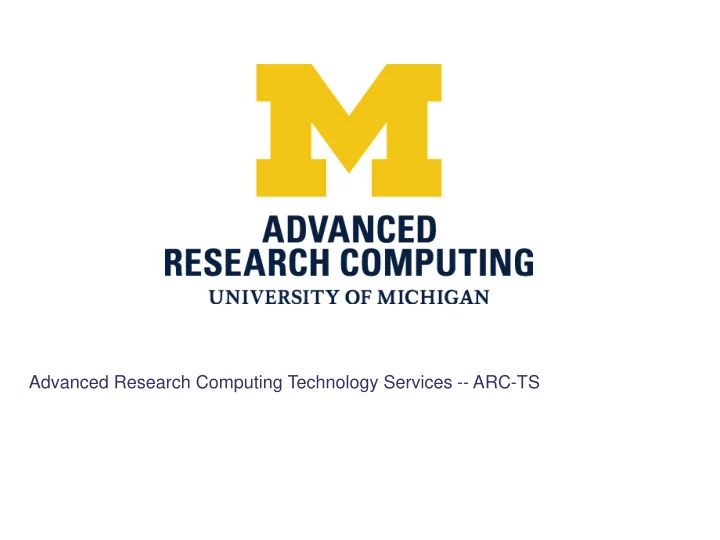

Advanced Research Computing Technology Services -- ARC-TS
Center for Data-Driven Computational Physics
Multiscale problems Transitional boundary layer Supersonic combustion Shock train
Simulation of multiscale physics Macroscale model Can compute Cannot compute Microscale quantities everywhere Closure problem Macroscale model can only involve macroscale quantities Professor Karthik Durasaimy (Aerospace Engineering)
Materials Modeling The goal is to identify, explain, predict and ultimately to design the properties and responses of these materials. Hierarchical models have been developed at several scales These methods have thus far provided insight and qualitative connections to parameters and phenomena from lower scales, but have not been predictive Quantum Monte Carlo <-> Density Functional Theory <-> Continuum physics Profs. Vikram Gavini and Krishna Garikipati (Mech Engineering and Materials Science)
Subject-specific blood flow modeling Biggest challenges - lack of physiologic data to inform the boundary conditions - lack of data on mechanical properties of the vascular model Obtain data from tomography and MRI Solve inverse problem for parameters Massive data size On-the-fly Lagrangian computation of Motion Evaluation of arterial stiffness from medical Images ! Prof. Alberto Figueroa (Biomedical Engineering & Surgery)
Climate system interactions The Earth's climate system is composed of multiple interacting components that span spatial scales of 13 orders of magnitude and temporal scales that range from microseconds to centuries. key responses and feed backs in the system are not well characterized Understanding how clouds interact with the larger scale circulation, thermodynamic state, and radiative balance is one of the most challenging problems We use statistical inversion and machine learning to explore the interaction between changes in the Earths climate system and the radiative fluxes, circulation, and precipitation generated by large scale organized cloud systems. Profs. Derek Posselt and Allison Steiner (Atmospheric Oceanic & Space Sciences)
Common problem: Highly complex systems (many variables and often unknown relationship) Multi-Scale (time and space) Require extreme hi-resolution for accuracy in the details
Proposed approach to the problem Merge Machine Learning with traditional HPC Large scale data-driven simulations to enable accurate construction of models “Infer” the modeling link between micro and macro scales
Procedure Assembly Collection of relevant / necessary data Data Inverse modeling Extreme-scale optimization Information Machine Learning Noisy, Complex, Extreme-scale data, Modeling feature set selection Knowledge Embedding UQ and Computational Efficiency Predictive capability
Example: Wind turbine predictions Get data from some blade shapes Predict for other blade shapes
prediction ! Singh, A., Medida, S. & Duraisamy, K., Data- augmented Predictive Modeling of Turbulent Separated Flows over Airfoils Submitted, AIAA Journal, 2016 (arXiv)
What does it take ? Data & Physics & Computational Modeling Science High Performance Computing
NSF funded PoC What do we need ? Significant Computational Capability Fast Multi-process/thread systems CPU HPC & Big Data scheduling GPU NVIDIA GPU (P100) Extremely Fast Communication Node Node ~100 Gb/s for High Speed Network CPU GPU NVIDIA NVLink GPU GPU Flexible Storage Large ~1.5 PB growing to >3 PB over time Fast HDFS Support Efficient Shared Filesystem Can Handle HPC and Data Intensive Workloads
What we got from IBM • 47 x POWER8 S822LC Systems • 15 x POWER8 S822LC with 4 x NVIDIA P100 & NVLink • 100 Gb/s EDR Infiniband non-blocking fat-tree • CAPI • Elastic Storage Server • Spectrum Scale • Platform LSF
What we learned so far • Power8 is ~ 2-3 x faster for most of our code Intel Centric Special options for PPC (MASS, ESSL) • SMT8 is a real thing, but ... • Just now trying the P100s and NVLink – > fast !
Recommend
More recommend